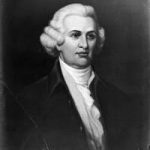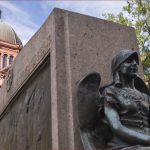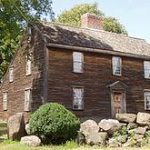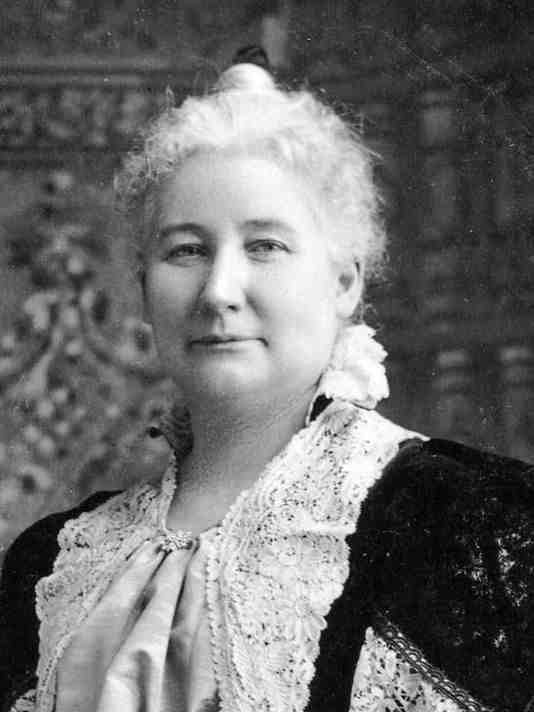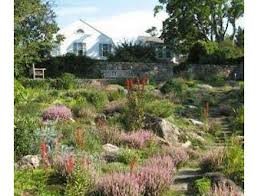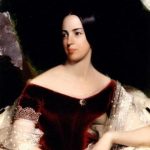Washington DC Socialite and Photographer
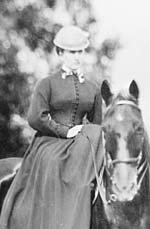 Clover Adams was a socialite, an active hostess in Washington, DC society, an accomplished amateur photographer, and one of the earliest portrait photographers in the United States. Her work was widely admired, but her husband, historian Henry Adams, would not allow her to become a professional and discouraged any publication of her work.
Clover Adams was a socialite, an active hostess in Washington, DC society, an accomplished amateur photographer, and one of the earliest portrait photographers in the United States. Her work was widely admired, but her husband, historian Henry Adams, would not allow her to become a professional and discouraged any publication of her work.
Image: Clover Adams on horseback at Beverly Farms, October 1869
The photo shown here is the only known adult photograph of Clover; no close–up picture of her face exists. After her death, Henry Adams destroyed all of her photos in their home, and neither her father nor her family had ever received a picture of Clover’s face.
(Marian) Clover Hooper was born on September 13, 1843, in Boston, Massachusetts, the third and youngest child of Dr. Robert William Hooper and Ellen Sturgis Hooper. The Hooper family was wealthy and prominent. Her mother, a Transcendentalist poet, died of tuberculosis when Clover was five years old. She and her two siblings were raised by her father and she became very close to him. She was educated in Cambridge at Elizabeth Agassiz’ girl’s school in Cambridge.
During the Civil War, Clover Hooper volunteered for the U.S. Sanitary Commission, which promoted clean and healthy conditions in the Union Army camps. The Commission staffed field hospitals, raised money, provided supplies, and worked to educate the military and government on matters of health and sanitation. Women volunteers organized medical services or worked as nurses at the field hospitals and camps.
Henry Brooks Adams was born on February 16, 1838, in Boston, Massachusetts, to one of America’s most prominent families: his grandfather was the 6th US President John Quincy Adams and his great-grandparents were John and Abigail Adams. Henry graduated from Harvard University in 1858. In 1860 his father, then a member of the United States Congress, asked Henry to be his private secretary, a familial role between father and son going back to John and John Quincy Adams.
On March 19, 1861, President Abraham Lincoln appointed Charles Francis Adams, Sr. US Ambassador to the United Kingdom, and Henry Adams accompanied him in his private secretary role. Just after the Civil War, Clover traveled abroad, where she met Henry Adams in London.
In 1868, Henry Adams returned to the United States and settled in Washington, DC, where he worked as a journalist exposing political corruption. From 1870 to 1877 he served as Professor of Medieval History at Harvard, then returned to Washington to continue work as a historian. Clover and her father were then living at their home in Beverly, Massachusetts.
On June 27, 1872, Clover married Henry Adams in Boston, and they spent their honeymoon in Europe. When they returned they bought a house at 91 Marlborough Street in Boston. Adams taught at Harvard and their home became a gathering place for intellectuals.
In 1877, Clover and Henry moved to Washington, DC, where their home on Lafayette Square, was across from the White House. Clover filled their palatial home with beautiful porcelains, Oriental rugs, silver antiques, Japanese bronzes and paintings by the Old Masters.
And there, on Lafayette Square, rimmed with elegant mansions, Clover oversaw a social life that included senators and representatives, artists and intellectuals, and the socially elite. She was known as a clever and outspoken woman, and has been cited as the inspiration for writer Henry James’ Daisy Miller (1878) and The Portrait of a Lady (1881). James remarked that Clover was a ”perfect Voltaire in petticoats.”
Clover attachment to her father remained throughout her marriage. During their first long separation, when Clover was on her honeymoon in 1872 along the Nile, she apparently suffered a brief nervous breakdown. Her gossipy letters to her father provide an insightful view of Washington and the politics of the day.
Photography
Clover took up photography in 1883 and her work was widely admired, although Henry Adams apparently discouraged publication of her pictures. She was one of the earliest portrait photographers, and the few pieces of her work that remain reveal an extraordinary talent. Familiarizing herself with the chemicals, she did her own developing.
Her photographs consist of formal and informal portraits of politicians, family friends, various members of the Adams and Hooper families, family pets, and still lifes of interior and exterior locales, including Washington; Bladensburg, Maryland; and the Adams family homes in Quincy and Beverly Farms, Massachusetts.
These images provide insights into 19th century America and a woman’s place in it. Clover also left behind a great deal of information about photography, including meticulous chronological notes she kept while working in her darkroom, listing photographs and commenting on exposures, lighting, et cetera.
Final Years
Henry Adams wrote two novels in the 1880s: Democracy: An American Novel and Esther. From her remarks written in letters, it was widely speculated that Clover was the ‘anonymous’ author of Democracy, which was not credited to her husband until 43 years later. It was the first Washington political novel to be an international bestseller.
The most exclusive group in Washington at that time called themselves the Five of Hearts: Henry and Clover Adams, Clara and John Hay (Lincoln’s secretary) and Clarence King, head of the Geological Survey. They were all suspected of writing Democracy.
Some said Clover admitted that she was the author of the novel. Even her father and her aunts suspected Clover had written it. But no one ever publicly acknowledged writing it, and publisher Henry Holt attributed the book to Henry Adams in 1923, after his death.
Clover and Henry Adams hired architect H.H. Richardson to build a new home for them on Lafayette Square, across from the White House. The new house would be adjacent to the Richardson-designed house being built for John Hay, President Lincoln’s secretary during the Civil War. While awaiting the completion of their new home, they rented a house nearby on H Street. Clover documented the construction of the houses with her camera.
The death of her father on April 13, 1885, initiated a period of mourning from which she did not recover. She sank into bouts of overwhelming grief and depression, an illness that seemed to plague a number of her family members.
On Sunday morning, December 6, 1885, after a late breakfast at their rented home, Clover went to her room. Henry Adams, troubled by a toothache, had planned to see his dentist. While leaving the house, he was met by a woman calling to see his wife.
Adams went upstairs to Clover’s room to ask if she would receive the visitor and found his wife lying on a rug before the fire. Adams carried his wife to a sofa, then ran for a doctor. Shortly thereafter, Dr. Charles E. Hagner pronounced Clover dead. Nearby lay a vial of potassium cyanide, which she had used to develop her photographs. A strange smell confirmed the worst.
Clover Adams had committed suicide by swallowing potassium cyanide on December 6, 1885, at age 42 at her temporary home on H Street in Washington, DC. The capital was stunned by the news. Washington newspapers reported that she had suddenly dropped dead from paralysis of the heart.
Henry, his brother, Charles Francis Adams, and Clover’s brother Edward and sister Ellen attended a brief funeral service held on December 9, 1885, at the house on H Street. Interment services followed at Rock Creek Cemetery but the actual burial was postponed until December 11, 1885, because of inclement weather. A few weeks later Adams ordered a modest head stone as a temporary marker.
In a letter to Henry Adams, John Hay wrote:
Is it any consolation to remember her as she was? That bright, intrepid spirit, that keen, fine intellect, that lofty scorn for all that was mean, that social charm which made your house such a one as Washington never knew before and made hundreds of people love her as much as they admired her.
Henry Adams destroyed the letters she had written to him and all of the photographs in the house. Neither her father nor her family had ever received a picture of Clover’s face. Only a single, blurred photograph of Clover remains.
The Hooper Curse?
There has been much speculation and numerous theories concerning the causes of Clover Adams’ suicide. These include a family history of mental depression and suicide and a sense of frustration and unfulfillment as a cultured person and as a woman.
As girls, Clover and her sister Ellen had accompanied their father on his charitable professional visits to Worcester Asylum for the mentally ill, so they were aware of the terrors that lay within those walls. In subsequent letters, they revealed their vulnerabilities and fears of confinement in these institutions. Clover’s letters also make it clear that she regarded suicide as preferable to commitment or becoming a burden for family or friends.
Both Clover’s mother, Ellen Sturgis Hooper, and Grandmother Sturgis had a tendency toward depression. As a child, Clover was present when her aunt, Susan Sturgis Bigelow, had taken arsenic that ended her life and that of her unborn child.
Henry’s brother Charles reportedly said to him when learning of his brother’s intended proposal, “Heavens!—no— they’re all crazy as coots. She’ll kill herself just like her aunt!” And Henry was certainly aware of the family history when he wrote his brother Brooks, “I know better than anyone the risks I run. But I have weighed them carefully and accept them.”
Growing up, Clover had the advantages of wealth and social position. Her mother and her aunt had poems published in The Dial, the journal of Transcendentalism, and were articulate feminists. These models and mentors gave voice to the thesis that women were the intellectual equals of men. And around the hearth of Dr. Hooper’s home, Ralph Waldo Emerson, Oliver Wendell Holmes, and Henry James exchanged ideas.
In this atmosphere of learning, there would seem to be no limits for Clover’s education, but she could not follow her brother Edward to Harvard nor to any other college; at that time, women were not admitted. Henry Adams certainly did not lessen Clover’s later feelings of educational inadequacy.
In a letter to Charles Milnes Gaskell, Henry Adams wrote:
She desires me to say to you that – all I said about her accomplishments is a lie – In fact it is rather droll to examine women’s minds. They are a queer mixture of odds and ends, poorly mastered and utterly unconnected – My young female has a very active and quick mind and has run over many things, but she really knows nothing well, and laughs at the idea of being thought a blue [bluestocking, i.e., intellectual]. She commissions me to tell you that she would add a few lines to this letter, but unfortunately she is unable to spell.
In a letter to her father on February 5, 1882, Clover confided that her educational experiences were lacking, “though excellent exercises in themselves, are as useless in the sea of real life as a dory without oars.”
While her husband established his reputation as a prominent writer and historian, Clover developed her ability as a talented portrait photographer of her family and the notables of her circle. In December 1884 her photograph of George Bancroft, an eminent historian, was requested for publication in the Century Magazine to be accompanied by a short article about Bancroft by Henry Adams.
It was a perfect opportunity for Adams to show pride and support and to share Clover’s pleasure at being recognized for her accomplishment at a professional level. He rejected the proposal, supposedly because it might have encouraged or offended others not so featured. Clover calmly reported the incident to her father without comment, as an obedient wife. But she must have been greatly disappointed at being denied a larger audience and wider recognition of her skills.
Perhaps Clover also doubted her self-worth. Before their marriage, Henry Adams had written to his friend, Charles Milnes Gaskell, “She is not handsome, nor would she be called quite plain.” He also wrote, “She is certainly not beautiful, and her features are much too prominent,” and his love of her “intelligence and sympathy,” and described her personality as “eccentric.”
The couple’s childlessness provoked questions about whether there was something wrong in the marriage. Regardless of who was responsible, the absence of children was a further source of guilt and inadequacy for Clover. She is reported to have exclaimed to her cousin Ann Lothrop, “If any woman ever says to you that she doesn’t want children, it isn’t true. All women want children.”
Two days before her suicide, Clover had visited a friend who was three months pregnant. It has been suggested that Clover’s sudden realization of her own barrenness further deepened her depression.
Clover’s dark despair was certainly not helped by her husband’s love affair with their neighbor in Washington, the beautiful and much younger Elizabeth Sherman (Lizzie) Cameron. In the fall of 1881, the Adamses had met Lizzie, who was unhappily married to the alcoholic Senator J. Donald Cameron of Pennsylvania.
American novelist Henry James was to say that the affair between Henry and Lizzie was “one of the longest and oddest American liaisons I’ve ever known. Women have been hanged for less – and yet men have been too, I judge, rewarded with more.”
And that Hooper Curse? Two years after Clover’s death, her sister Ellen, anguishing over the death of her husband, walked into the path of an oncoming train. Her brother Edward suffered a nervous breakdown for six weeks as a result of that tragedy, and in 1901 he leaped from the third floor of his home, survived briefly, but died two months later of pneumonia in an asylum.
The Clover Adams Memorial
In 1888 Henry Adams turned to a friend, sculptor Augustus Saint-Gaudens, for help in designing a monument to Clover in Rock Creek Park, Washington, DC. The year after his wife’s death, while still mulling over the matter of a monument, he paid an extended visit to Japan and spent hours studying Buddhist statues. To help Saint-Gaudens in his work, Adams sent him photographs, asking the artist to infuse in the statue the art of both East and West.
By early 1891 Saint-Gaudens had completed what many consider his masterpiece: a bronze statue of a draped and cowled figure seated on rock and leaning against a granite backdrop. The figure in a contemplative pose, its right hand touching its chin, is enveloped in a cowled garment from head to foot. The face is strong with a straight nose, full lips, a firm chin and closed eyes. A male model was used for the figure, which has a genderless quality.
The setting for the monument was designed by another of Adams’ celebrated friend, Stanford White. Wanting the whole effect to be universal and architecturally sexless, Adams instructed White that the setting should have ”nothing to say.” The sculpture and base occupy one side of the monument’s six-sided design, which is 20 feet across. Facing the monument is a long pink granite bench that takes up three sides of the designed space.
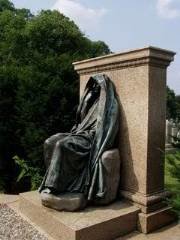
Image: The Clover Adams Memorial
Erected in 1891, the monument was commissioned by author/historian Henry Adams as a memorial to his wife, Marian “Clover” Hooper Adams. It is located in Section E of Rock Creek Cemetery in Washington, DC, and features a cast bronze sculpture by Augustus Saint-Gaudens. The shrouded figure is seated against a granite block, which forms one side of a hexagonal design in pink granite, created by architect Stanford White.
This haunting monument was completed and installed in March 1891. The statue and its gray granite seat rest upon a polished pink granite base. A larger vertical block of the same granite forms a backdrop. The entire monument is hidden within a circle of shrubs and holly trees. Shadows cast by the shifting light across the edges of the cowl offer the only semblance of change to this otherwise impassive face. But most remarkably: the memorial has no name, no date, no epitaph – not even the sculptor’s identity.
Although Henry Adams had received photographs of the installed monument from Saint Gaudens, he did not visit Rock Creek Cemetery and sit before the Adams Memorial until mid–February 1892.
Henry Adams is considered one of the great writers of the late 19th and early 20th centuries. His greatest work is The History of the United States of America 1801 to 1817 (1889-91). His autobiography, The Education of Henry Adams, was published after his death and was awarded the Pulitzer Prize in 1919. In that book is found his only reference to his wife, a single sentence in which she is not mentioned by name.
In 1912 Henry Adams suffered a disabling stroke. He died at his Washington home in 1918, and now rests beneath the Adams Memorial with Clover.
His autobiography, The Education of Henry Adams, was published shortly after his death and won a Pulitzer Prize in 1919, though he originally wrote it for private circulation. He was so reticent about his wife and her death that he wrote about the Adams Memorial without mentioning whom it memorialized. “The interest of the figure was not in its meaning,” he wrote, “but in the response of the observer.”
Books about Clover Hooper Adams:
Clover: The Tragic Love Story of Clover and Henry Adams and Their Brilliant Life in America’s Gilded Age, by Otto Friedrich. New York: Simon and Schuster, 1979.
The Education of Mrs. Henry Adams, by Eugenia Kaledin. Philadelphia: Temple University Press, 1981.
Clover, by Freidrich Otto. New York: Simon and Schuster, 1979.
The Letters of Mrs. Henry Adams, 1865-1883, ed. by Ward Thoron. Boston: Little, Brown and Co., 1936.
SOURCES
Marian Hooper Adams
The Small Folks at Home
A Wordless Anonymous Memorial
